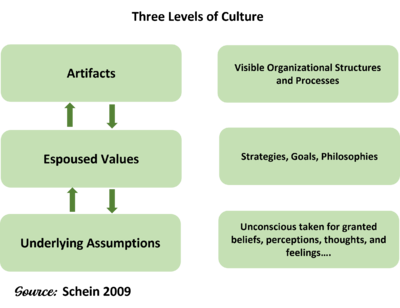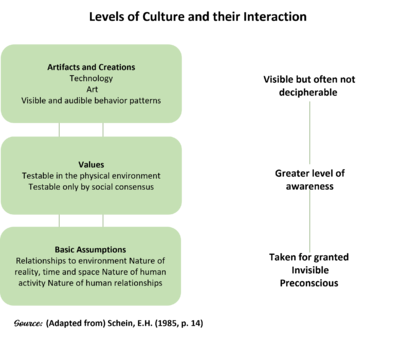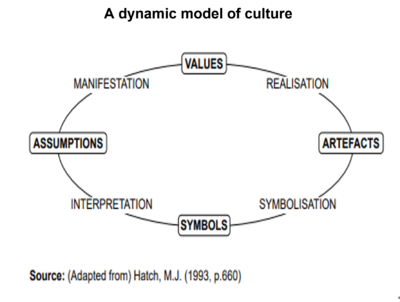Culture Levels
As the continuation of successful action (Baecker, 1999), culture shows the materialized "information processing" of a social system. Culture provides the structure in which action is possible, and as such reduces complexity to a degree that is manageable for the system (Luhmann,1984; Baecker,1999). But structure is virtual (Giddens, 1984) and only becomes visible through social norms and actions.
In the 1980s, psychologist Edgar Schein of the Sloan School of Management developed a model for understanding and analyzing organizational culture. Schein divided an organization’s culture into three distinct levels: artifacts, values, and assumptions.
- Artifacts are the overt and obvious elements of an organization. They’re typically the things even an outsider can see, such as furniture and office layout, dress norms, inside jokes, and mantras. Yes, foosball and free food are also artifacts. Artifacts can be easy to observe but sometimes difficult to understand, especially if your analysis of a culture never goes any deeper. The Palo Alto office of IDEO famously has an airplane wing jutting out from one wall, a surprising and puzzling artifact if one doesn’t understand IDEO’s culture of playful experimentation and free expression.
- Espoused values are the company’s declared set of values and norms. Values affect how members interact and represent the organization. Most often, values are reinforced in public declarations, like the aptly named list of core values, but also in the common phrases and norms individuals repeat often. Herb Kelleher was famous for responding to a variety of proposals from Southwest colleagues with the phrase “low cost airline,” reaffirming the espoused value of affordability.
- Shared basic assumptions are the bedrock of organizational culture. They are the beliefs and behaviors so deeply embedded that they can sometimes go unnoticed. But basic assumptions are the essence of culture, and the plumb line that espoused values and artifacts square themselves against. Zappos call center employees share a strong belief that providing outstanding service will result in loyal customers, so much so that employees send potential customers to other retailers if Zappos doesn’t have the item in stock. Basic assumptions manifest themselves in a variety of ways. Sometimes they’re reflected in the espoused values and in artifacts, sometimes not. But when basic organizational assumptions don’t align with espoused values, trouble arises. Enron produced a 64-page manual outlining the company’s mission and espousing its core values, but judging by their very “creative” accounting practices, it’s questionable if the executives at the top had ever read it.[1]
In his 1984 article 'Coming to a New Awareness of Organizational Culture', Schein defines Organizational culture as "the pattern of basic assumptions that a given group has invented, discovered, or developed in learning to cope with its problems of external adaptation and internal integration, and that has worked well enough to be considered valid, and, therefore, to be taught to new members as the correct way to perceive, think, and feel in relation to those problems."
Schein's view of culture on these three levels has been described as “one of the only conceptual models ever offered” (Hatch, 1993, p. 658). Schein’s (1985) model of culture emphasizes distinguishable categories of organizational culture which have commonly become known as the three components of organizational culture (Ott, 1989). Schein’s (1985) conceptualization of culture is shown in the Figure below.
The Processes of Culture
Hatch (1993) argues that Schein’s (1985) model of culture over-emphasizes the components of culture to the detriment of processes which link the components of organizational culture. Indeed, what is implicit to a distinguishable component conceptualization of organizational culture (i.e. that culture is constituted of artefacts, values and assumptions) is the assumption that such components are linked by processes, (that is, the components of culture interact with each other). Hatch (1993) presents the “Cultural Dynamics Model” of organizational culture which explicitly focuses on these dynamic relations (see Figure below).
Adopting a symbolic interactionist perspective Hatch (1993) extends and develops Schein’s (1985) model through focusing on both the two-way processes and four components of culture. However, notwithstanding the contribution of Hatch’s (1993) emphasis on the processes of culture, many “mainstream” theorists consider symbols to be an element of cultural artefacts (for example; Ott, 1989). Such theorists contend that since assumptions, values and artefacts of culture may have symbolic meaning, such symbols do not constitute a component of culture in their own right.
Cultural Pluralism
Young (1989) notes that the model of Schein (1985) is also weakened by the implicit underlying presumption of cultural unity. Schein’s (1985) assumption of a single organizational culture is inconsistent with much of organizational culture research. Indeed, Pettigrew (1979, p. 574) argues that “culture treated as a unitary concept … lacks analytical bite”. Thus, many theorists have developed pluralist perspectives of culture along with a variety of labels for the sub-divisions of culture, for example Ouchi’s (1981) “clans”, Gregory’s (1983) “native views”, Morgan’s (1986) “mosaics” and Sackman’s (1992) more conventional, “subcultures”. An issue which is consistent with the majority of these views is that the boundary of a culture is determined by the extent of shared meaning. Indeed, many organizational theorists would argue that without a shared meaning, a culture (be it unitary or pluralist) cannot be defined or distinguished (that is, it is the shared meanings of organizational members
which defines culture).
Therefore, organizational culture can be viewed as a mosaic of subcultural shared meaning (often with similar traits) which are bounded by the frontiers of the organization. Thus, strong cultures (Robbins, 1983) with unified beliefs and artefacts can be viewed as a series of subcultures integrated by a dominant set of beliefs (Martin, 1992)[2]
Organizational Culture Pyramids
In 2019, Granter used Schein’s pyramid idea and added a level above the artifacts level. Here is a breakdown of his interpretation of the organizational culture pyramids:
| Levels of organizational culture (Source: Granter, 2019) | |
| Levels of Organizational Culture | Manifested through |
| 1. Superstructural/ideological | Acceptance of dominant national economic regimes. Reactions to social and economic change. |
| 2. Symbolic (Artifacts) | Corporate logos, uniforms, rituals, stories, events, “heroes,” posters, buildings, layout, purported organizational structure. |
| 3. Discursive (Values) | Buzzwords and phrases, renaming roles/unites, “culture change,” values and culture explicitly espoused by the organization, technical or professional norms and rules. Rules imposed by the organization. |
| 4. Affective and cognitive (Underlying assumptions) | Workers’ sense of identity, attitudes towards and feelings about the manifestations of levels 1–3, trust in organizations’ espoused versions of 2–3, understanding of the “reality” of working in the organization. Tacit knowledge of how things work. |
Granter argues there is an even broader version of culture than that of artifacts. According to Granter, the super-structural level takes into account social and economic change and the influence they have on the entire organizational cultural pyramid. Both Schein and Granter present a new level of complexity to organizational culture and help to explain its intricacies and inner workings.[3]
See Also
References
- ↑ Edgar Schein's Three Levels of Culture Harvard Business Review
- ↑ The Processes of Culture and Cultural Pluralism Lloyd C. Harris
- ↑ Granter's Organizational Vulture Pyramids Lumen Learning



